The Kerala Pilgrimage Destinations are an excellent illustration of secular co-existence and religious harmony. There are several pilgrimage destinations all over Kerala, India that cater to the spiritual needs of people belonging to different faiths be it Hindus, Muslims, Christians or any other faith.
Pilgrims come all over India for pilgrimage tours to the several pilgrimage destinations located in Kerala, South India.
Guruvayur Temple |
|
Padmanabhaswamy Temple |
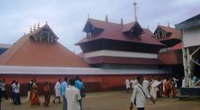 Dedicated to the deity Lord Guruvayur appan, the temple at Guruvayur is one of the most important pilgrimage destinations in Kerala, South India. Come and experience a special form of happiness as you get a darshan of Lord Guruvayurappan or Lord Krishna at the temple at Guruvayur, Kerala, South India Dedicated to the deity Lord Guruvayur appan, the temple at Guruvayur is one of the most important pilgrimage destinations in Kerala, South India. Come and experience a special form of happiness as you get a darshan of Lord Guruvayurappan or Lord Krishna at the temple at Guruvayur, Kerala, South India |
|
 This temple, a sprawling complex with a magnificent seven storied tower houses the idol of Lord Vishnu in the form of Ananthapadmanaoha (the Lord who upheld creation on a lotus which sprang forth from His navel). The 6 m image, partly covered with gold and embellished with precious stones is viewed in three sections through three doors. This temple, a sprawling complex with a magnificent seven storied tower houses the idol of Lord Vishnu in the form of Ananthapadmanaoha (the Lord who upheld creation on a lotus which sprang forth from His navel). The 6 m image, partly covered with gold and embellished with precious stones is viewed in three sections through three doors. |
| |
|
|
Attukal Bhagavathi Temple |
|
Sree Parasurama Temple, |
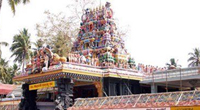 Known as the Saoarimala of women, this temple is famous for Attukal Ponkala, the annual festival that commences on Bharani day in Kumbhom (February - March). The highlight of the festival is the Ponkala which is an all woman affair. Ponkala is an offering made in Bhagavathy temples, prepared in the form of payasam (sweet porridge) with ingredients like rice, jaggery. Coconut kernel and plantain. Ponkala starts in the morning and ends with the melsanthi (chief priest) sprinkling holy water over the offerings. Known as the Saoarimala of women, this temple is famous for Attukal Ponkala, the annual festival that commences on Bharani day in Kumbhom (February - March). The highlight of the festival is the Ponkala which is an all woman affair. Ponkala is an offering made in Bhagavathy temples, prepared in the form of payasam (sweet porridge) with ingredients like rice, jaggery. Coconut kernel and plantain. Ponkala starts in the morning and ends with the melsanthi (chief priest) sprinkling holy water over the offerings. |
|
Thiruvallam (5 km from Thiruvananthapuram)
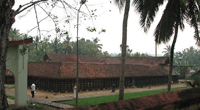 This is the only temple in Kerala dedicated to Sree Parasurama, the mythological creator of Kerala. This 2000year-old temple is a venue for the Bali ritual for departed souls. This is the only temple in Kerala dedicated to Sree Parasurama, the mythological creator of Kerala. This 2000year-old temple is a venue for the Bali ritual for departed souls.
|
| |
|
|
| Bheemappalli |
|
Christ the King Church, Vettukadu |
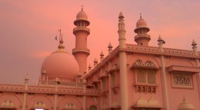 Southwest of Southwest of
This mosque is famous for the Chandanakkudam Festival which is said to be the death anniversary of Bheema Beevi, a devout pilgrim who came to Kerala from Mecca. Festivities include devotees going round the mosque carrying earthen pots (kudam) smeared with sandal wood paste. The Uroose festival here is also famous. |
|
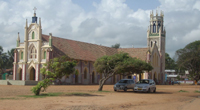 An important pilgrim centre, this church is famous for the annual festival in November. High Mass, Vespers, a two hour long Holy Eucharistic procession and benediction are the highlights of the festival. Nativity feast of the Blessed Virgin Mary is also celebrated with religious spirit. |
|
|
|
Varkala(40 km from Thiruvananthapuram) |
|
Lord Ayyappa Temple, Aryankavu |
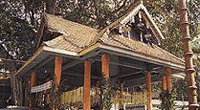 Sivagiri Mutt in Varkala is the final resting- place of the great social reformer. Sree Narayana Guru. The Papanasham (redemption from sins) beach here is the place whereNarada is believed to have thrown his valkalam. The 2000 year old Sree Janardhana Swamy temple here is famous for the Arattu, the annual festival celebrated in March-April. Sivagiri Mutt in Varkala is the final resting- place of the great social reformer. Sree Narayana Guru. The Papanasham (redemption from sins) beach here is the place whereNarada is believed to have thrown his valkalam. The 2000 year old Sree Janardhana Swamy temple here is famous for the Arattu, the annual festival celebrated in March-April.
|
|
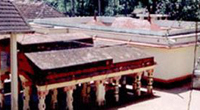 This pilgrim centre has exquisite sculptures and mural paintings. Mandala pooja and Thrikalyanam celebrated in December are the main festivals here. |
| |
|
|
Mata Amritanandamayi Mutt |
|
Sree Vallabha Temple, Thiruvalla |
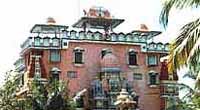 Mata Amritanandamayi Devi was born Sudhamani Idamannel in the small village of Parayakadavu (now partially known as Amritapuri), Alappad Panchayat, Kollam District, Kerala in 1953.[5] Her schooling ended when she was nine, and she began to take care of her younger siblings and the family domestic work full-time |
|
 Dedicated to Lord Vishnu. This temple houses a tank supposed to be a natural one. Ladies are allowed entry to the sanctum sanctorum only on two days. Vishu and Thiruvathira. The annual festival. Uthraseeveli is celebrated on the Makayiram asterism in Meenam (March - April). Dedicated to Lord Vishnu. This temple houses a tank supposed to be a natural one. Ladies are allowed entry to the sanctum sanctorum only on two days. Vishu and Thiruvathira. The annual festival. Uthraseeveli is celebrated on the Makayiram asterism in Meenam (March - April).
|
| |
|
|
Parthasarathy Temple, Aranmula |
|
Ayyappa Temple, Sabarimala |
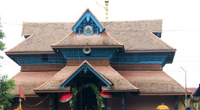 The Aranmula Parthasarathy Temple iis a Hindu temple near Aranmula, a village in Pathanamthitta District,Kerala, South India.Aranmula Pardhasaradhi Temple Aranmula Uthrattathi Boat Race Aranmula Snake Boat race at Pathanamthitta The temple is on the left bank of the Pampa River. It is from here that the sacred jewels of Ayyappan are taken in procession to Sabarimalai each year. Aranmula is also known for the watersports involving a spectacular procession of snake boats. It is also linked with legends from the Mahabharata.It is one of the most important Krishna temples in Kerala, the others being at Guruvayur, Trichambaram, Tiruvarppu and Ambalappuzha. The Aranmula Parthasarathy Temple iis a Hindu temple near Aranmula, a village in Pathanamthitta District,Kerala, South India.Aranmula Pardhasaradhi Temple Aranmula Uthrattathi Boat Race Aranmula Snake Boat race at Pathanamthitta The temple is on the left bank of the Pampa River. It is from here that the sacred jewels of Ayyappan are taken in procession to Sabarimalai each year. Aranmula is also known for the watersports involving a spectacular procession of snake boats. It is also linked with legends from the Mahabharata.It is one of the most important Krishna temples in Kerala, the others being at Guruvayur, Trichambaram, Tiruvarppu and Ambalappuzha. |
|
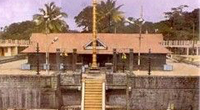 A well-known pilgrim centre in the rugged terrain of the Western Ghats, this temple is dedicated to Lord Ayyappa. Sabarimala is surrounded by hazardous hills like Karimala and Neelimala. The devotees known as Ayyappas negotiate the hills to reach the shrine after undergoing 41 days of v rutham (self-imposed devotional penance). The pilgrimage season, viz.Mandala Pooja and, Makaravilakku comes between the latter half of November and the first half of January, every year. Ablution in River Pamba is considered as holy as a dip in the Ganga. The presence of Ayyappa's |
| |
|
|
Maramon Convention, Kozhencherry |
|
Mannarasala Temple |
 The Maramon convention is an assembly of Christians from all over India, who come here to listen to the gospels as read and expounded by scholars of Christianity throughout India and abroad.Preaching and Bible study occupy the major part of the convention. Besides religious reading and discourse, singing of hymns and faith-healing sessions are conducted. The Maramon convention is an assembly of Christians from all over India, who come here to listen to the gospels as read and expounded by scholars of Christianity throughout India and abroad.Preaching and Bible study occupy the major part of the convention. Besides religious reading and discourse, singing of hymns and faith-healing sessions are conducted.
|
|
 This is the most significant site of snake worship in Kerala and houses 30.000 images of snake-gods. The shrine is under the patronage of a Namboodiri family whose oldest female member performs the role of the temple priestess. Legend has it that the first priestess of Mannarasala gave birth to a five-headed snake, which is believed to reside in the illam (ancestral house) to safeguard the family. On the day of Ayilliam asterism in the Malaya1.am months of Kanni and Thulam (September to November), all the serpent idols in the grove and the temple are taken in a procession to the illam where Nurum Palum (rice flour and milk) and Kuruthi (a red liquid made of turmeric and lime) offerings are made. At Mannarasala, barren women are believed to be blessed with children. |
| Chettikulangara Devi Temple |
|
Sree Krishna Temple, Ambalapuzha |
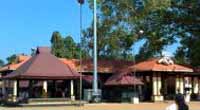 One of the renowned Devi temples in Kerala, this temple is famous for the Bharani festival. celebrated in February/March. The highlights of this festival are Kuthiyottam and Kettukazhcha, Of these, the former is performed as an offering to the Goddess. The man who makes the offering teaches an adolescent boy religious rites for seven days from Sivarathri day (in February) to Bharalli asterism, during which period the boy observes fast. On Bharani morning, the boy with his body coiled with silver wires is taken in a procession to the temple. Later in the afternoon, devotees place huge decorated effigies of chariots, horses, epic figures such as Bhima, Panchali and Hanuman, in the paddy field lying east of the temple. During the night, the image of Devi is carried in a procession to the effigies stationed in the paddy field. This is Kettukazhcha . These effigies are later taken to their respective kavus (place of worship of different families). |
|
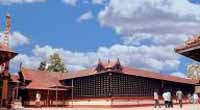 In its architectural features, the Sree Krishna Temple conforms to the typical Kerala style. The temple is famous for Palpayasam milk porridge of exceptional sweetness offered to the deity. The deity here has been worshipped by great literary figures in Kerala's history like Melpatthur Narayana Bhattathirippad, Thunchath Ezhuthachan and Kalakath Kunchan Nambiar. It is also here that the Pallipana is performed by Velans (sorcerers) every twelve years. |
Malayatoor |
|
Shiva Temple, Aluva(20 km from Ernakulam) |
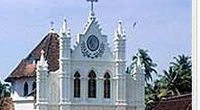 This place is famous for the Catholic Church on the 609m high Malayatoor hill (dedicated to St. Thomas). Thousands of devotees undertake the pilgrimage to the shrine to participate in the annual festival-Malayatoor PtrllIl1/al (March/April). St. Thomas is believed to have visited here. |
|
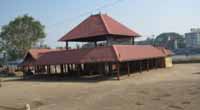 Situated on the banks of River Periyar, the Shivalinga of this temple rises out of the sandbanks of the river and is believed to have worshipped by Lord Rama. During the monsoon season the whole region gets flooded and the idol gets submerged in water. Worship is then done in a small shrine on the upper banks of the river. A dip in this river at the brahmamuhurtha (3 am) after observing the rituals of Shivarathri is considered very sacred. |
| |
|
|
|






 Dedicated to the deity Lord Guruvayur appan, the temple at Guruvayur is one of the most important pilgrimage destinations in Kerala, South India. Come and experience a special form of happiness as you get a darshan of Lord Guruvayurappan or Lord Krishna at the temple at Guruvayur, Kerala, South India
Dedicated to the deity Lord Guruvayur appan, the temple at Guruvayur is one of the most important pilgrimage destinations in Kerala, South India. Come and experience a special form of happiness as you get a darshan of Lord Guruvayurappan or Lord Krishna at the temple at Guruvayur, Kerala, South India  This temple, a sprawling complex with a magnificent seven storied tower houses the idol of Lord Vishnu in the form of Ananthapadmanaoha (the Lord who upheld creation on a lotus which sprang forth from His navel). The 6 m image, partly covered with gold and embellished with precious stones is viewed in three sections through three doors.
This temple, a sprawling complex with a magnificent seven storied tower houses the idol of Lord Vishnu in the form of Ananthapadmanaoha (the Lord who upheld creation on a lotus which sprang forth from His navel). The 6 m image, partly covered with gold and embellished with precious stones is viewed in three sections through three doors.  Known as the Saoarimala of women, this temple is famous for Attukal Ponkala, the annual festival that commences on Bharani day in Kumbhom (February - March). The highlight of the festival is the Ponkala which is an all woman affair. Ponkala is an offering made in Bhagavathy temples, prepared in the form of payasam (sweet porridge) with ingredients like rice, jaggery. Coconut kernel and plantain. Ponkala starts in the morning and ends with the melsanthi (chief priest) sprinkling holy water over the offerings.
Known as the Saoarimala of women, this temple is famous for Attukal Ponkala, the annual festival that commences on Bharani day in Kumbhom (February - March). The highlight of the festival is the Ponkala which is an all woman affair. Ponkala is an offering made in Bhagavathy temples, prepared in the form of payasam (sweet porridge) with ingredients like rice, jaggery. Coconut kernel and plantain. Ponkala starts in the morning and ends with the melsanthi (chief priest) sprinkling holy water over the offerings.












